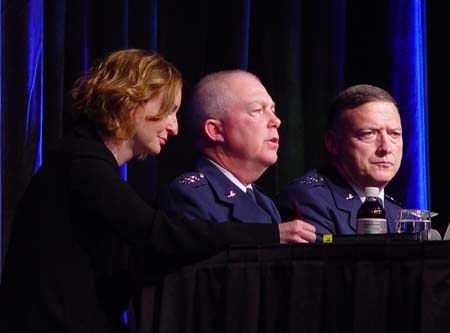The Air Force’s combat tempo in Afghanistan has increased exponentially since 2006, the top airman in Southwest Asia told the audience at AFA’s Air Warfare Symposium Thursday, and is expected to rise even more with the addition of 17,000 additional US forces. Lt. Gen. Gary North, commander of Air Forces Central and 9th Air Force, said of the 28,000 airmen in the US Central Command area of responsibility, 5,000 are now based in Afghanistan. As tactics for close air support have been refined and additional capability in areas such as airlift and intelligence, surveillance, and reconnaissance have been introduced into theater, the metrics tracking airpower in the conflict have risen sharply. Since 2006, the sortie requirements for airpower have increased by 170 percent—and the requests for weapons delivery have almost doubled between 2006 and 2008, thanks in large part to the improvements in connectivity with the joint terminal attack controllers on the ground. Airpower responses to troops in contact (TIC), urgent requests for air support ranging from a “show of force” to an airstrike on an ambush, have grown 300 percent in the same timeframe, while ISR sorties have exploded by 415 percent between 2006 and 2008. Behind the overall increase in action is strategic and tactical airlift, which North said was vital to operations in Afghanistan. He said there’s been a 450 percent increase in airdrops since 2006, aided greatly by the introduction of the joint precision airdrop system (JPADS). In 2008, the Air Force air dropped 15.6 million pounds into the country and North said he fully anticipates that number doubling in 2009.
Air Force’s combat tempo in Afghanistan has increased exponentially since 2006, the top airman in Southwest Asia told the audience at AFA’s Air Warfare Symposium Thursday, and is expected to rise even more with the addition of 17,000 additional US forces. Lt. Gen. Gary North, commander of Air Forces Central and 9th Air Force, said of the 28,000 airmen in the US Central Command area of responsibility, 5,000 are now based in Afghanistan. As tactics for close air support have been refined and additional capability in areas such as airlift and intelligence, surveillance, and reconnaissance have been introduced into theater, the metrics tracking airpower in the conflict have risen sharply. Since 2006, the sortie requirements for airpower have increased by 170 percent—and the requests for weapons delivery have almost doubled between 2006 and 2008, thanks in large part to the improvements in connectivity with the joint terminal attack controllers on the ground. Airpower responses to troops in contact (TIC), urgent requests for air support ranging from a “show of force” to an airstrike on an ambush, have grown 300 percent in the same timeframe, while ISR sorties have exploded by 415 percent between 2006 and 2008. Behind the overall increase in action is strategic and tactical airlift, which North said was vital to operations in Afghanistan. He said there’s been a 450 percent increase in airdrops since 2006, aided greatly by the introduction of the joint precision airdrop system (JPADS). In 2008, the Air Force air dropped 15.6 million pounds into the country and North said he fully anticipates that number doubling in 2009.
Lt. Gen. Stephen L. Davis, the Department of the Air Force’s top internal watchdog, has been nominated to lead Air Force Global Strike Command, which oversees the service’s bombers and intercontinental ballistic missiles.